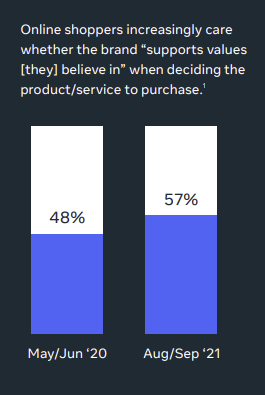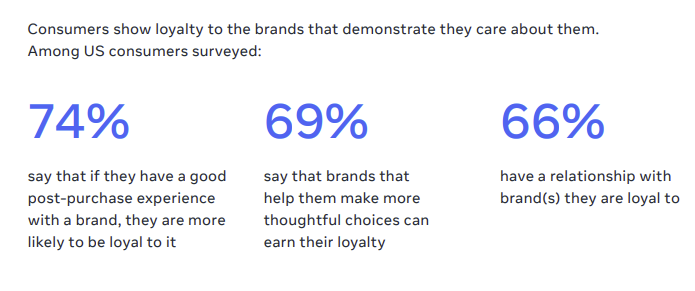Consumer behaviors are changing, and this week, Meta has published a new report, in partnership with GroupM, which highlights some of the key trends in online shopping engagement, and what they mean for your brand.
The 26-page report, which you can download here, examines the role of brand loyalty in the modern consumer process, and how businesses can better establish trust and community via online tools.
As per the report:
“When developing a strategy, it’s key to understand that loyalty is about more than just repeat shopping. Loyalty is based on reciprocity: It is founded in shoppers’ feelings that they are valued by a brand as much as they value the brand themselves. Research shows that having a personal connection with a brand is equally important, if not more, than financial incentive in influencing where people shop.”
According to the report, some 64% of surveyed shoppers tried different brands, websites and apps during the COVID-19 crisis, as they sought to fulfill their purchase needs. That presents new opportunities for brand exposure, and shows that online shoppers are more open to different brand approaches – which also means that businesses need to work harder than ever to establish connection, and build brand trust.
There are many reasons for this. The convenience of online shopping provides many more opportunities for comparison, while the fast-paced nature of social media feeds also leads to more brand exposure opportunities.
In addition, Meta notes that consumer priorities are changing.

What a brand stands for is now a much more important factor, with more people looking to positively contribute to their environment and community.
Expectations around the shopping experience itself are also rising, with 63% of respondents noting that they’ve abandoned a product or site due to mobile usability issues.
“Convenience is the cornerstone of eCommerce, and a driving reason that online shopping has accelerated at such an astounding rate. Today, free and fast shipping is table stakes, and people expect businesses to take the next step. According to 66% of surveyed US consumers, the brands that earn their digital loyalty are the ones that go above and beyond by making life easier. This could look like proactively communicating purchase delays, sending a delivery service to personally pick up returns or offering prepaid shipping labels.”
Systematic improvements like this also raise the bar for all other sites, because as online shopping becomes more convenient, consumers are increasingly less willing to tolerate roadblocks and delays to get what they want.
“Once people make up their minds, they want instant gratification, so the shopping experience should be quick and convenient, especially when it comes to delivery and returns. To continue shopping from an online website or app, 75% of surveyed US consumers say delivery speed is extremely important and 73% say the ease of returning items is.”
There’s also the expanded community, and the post-purchase flow, and how brands look to engage with customers to facilitate ongoing partnership.

There’s a lot to consider, but for the brands that can get it right, there are also significant benefits.
Loyal customers are 1.5x more likely than regular online shoppers to talk about their go-to shopping destinations, and with social media platforms giving everyone a voice, that can significantly expand your brand marketing efforts.
That alone makes this a key consideration, aside from meeting customer needs and aligning with evolving trends.
Which is really the key point – the way people shop is changing, and their expectations are also rising in-step. Brands need to recognize this, and these factors all play into that next-level experience, which can be delivered via your online channels.
There are some great notes in Meta’s full report, which you can download here, that could change how you approach your marketing efforts, and maximize process performance.
If you’re selling products online, it’s worth downloading the full report and checking out the expert insights.



